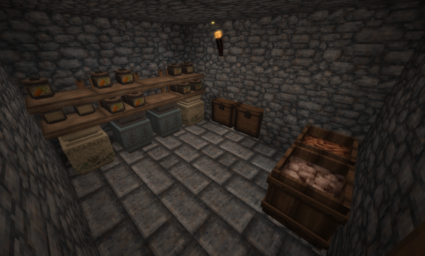Food preservation
Food rots over time, there are a few factors that affect food spoilage, outside of the food's innate rot time. Foods like grain can be kept in storage vessels to increase their already long shelf life. Whereas meats have a very short shelf life.
Factors affecting food spoilage
Climate
The climate in which the food is stored has an effect on the speed of food spoilage. Hot climates can increase the rate of decay up to 2.5x, while very cold ones can decreases the rate down to 0.1x. Only the climate at sea level is considered, so placing your food high up in the mountains will have no effect if the mountain is in a hot climate. To negate the impact of a warm climate, build a cellar.
Food type
Different types of foods have different fresh times.
| Food | Fresh time, hours |
|---|---|
| Raw meat | 36 |
| Cooked meat | 120 |
| Cured meat | 8760 |
| Vegetable | 504 |
| Pumpkin | 216 |
| Onion | 672 |
| Cooked Cattail Root | 48 |
| Pickled vegetable | 1800 |
| Fruit | 48 |
| Cranberries | 96 |
| Soybeans | 8760 |
| Pickled soybeans | 4320 |
| Grains | 2160 |
It is interesting that, unlike other pickled items, soybeans lose fresh time, but pickled soybeans are more useful as they can be eaten unlike raw soybeans
Food preservation methods
Due to the different components in foods, there are different methods to preserve each type or category of food. Almost all types of food items can be stored in the form of cooked meals, but it is not always practical to cook all food items into meals. Methods that are effective to preserve foods include
Salt curing and pickling
Curing meats only requires salt, with each unit of meat needing two units of salt, i.e. 32 meat uses 64 salt. After putting in the appropriate ingredients the barrel will state what it will make in the GUI, at this point the barrel must be sealed for 480 hours.
Pickling is slightly more complex, as it requires water to make brine. Otherwise, the process is very similar, each veggie or legume uses one unit of brine and remains sealed for 336 hours.
Once the food items are pickled or salt preserved, they can be kept in a basket, chest, or any other container.
Preserves and jam
To make jam, you need a cooking pot, a bucket, honey, and berries. Berries can be stored by making jam, which is prepared in the cooking pot. See the cooking page for the jam recipe.
Food preservation containers
While you can still store food in any stationary container, storage vessels are best for storing grains and vegetables. Storage vessels are fairly easy to make, requiring only clay. However, pickling is often the best in terms of longest shelf life.
Crocks
Four meals can be stored in crocks providing a slight reduction in food decay and is a good option for short term food storage. For long term storage, sealing the crocks with a lump of fat or wax reduces decay by a factor of 10. Filled crocks may be carried in player inventories.
Storage vessels
Storage vessels can store any unprepared food item can be stored in vessels, which provide storage benefits to grains and veggies. These vessels are good options for short and long term food storage as they reduce rotting to 75% for veggies and 50% for grains.
Cellars
To maximize the cellar effect when you decide to create a cellar in your build:
- Build your walls from solid soil, ceramic, or stone materials.
- Keep door count low. The best is no doors.
- Cellars should be no larger than 6 blocks in any direction. If the room exceeds this, it will not be recognized as a cellar.
Once you have created a cellar, you can place any food either on a solid block or inside containers. All items stored in the cellar will receive equal food decay reduction. You can verify the storage benefit by looking at the block info HUD. It will display something like Stored food perish speed: 0.25 - which in this case means food will last 4 times longer.
Effect stacking
Food preservation benefits from methods, containers, and locations stack, so it is best to combine as many preservation solutions as possible. Generally, all food should be stored in a cellar.
